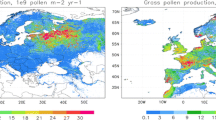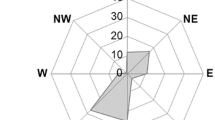Abstract
Olives are one of the largest crops in the Mediterranean and in central and southern Italy. This work investigates the correlation of the Olea europaea L. pollen season in Perugia, the capital city of the region of Umbria in central Italy, with atmospheric parameters. The aim of the study is twofold. First, we study the correlation between the pollen season and the surface air temperature of the spring and late spring in Perugia. Second, the correlation between the pollen season and large-scale atmospheric patterns is investigated. The average surface temperature in the spring and late spring has a clear impact on the pollen season in Perugia. Years with higher average temperatures have an earlier onset of the pollen season. In particular, a 1°C higher (lower) average surface temperature corresponds to an earlier (later) start of the pollen season of about 1 week. The correlation between the pollen season and large-scale atmospheric patterns of sea level pressure and 500-hPa geopotential height shows that the cyclonic activity in the Mediterranean is unequivocally tied to the pollen season in Perugia. A larger than average cyclonic activity in the Mediterranean Basin corresponds to a later than average pollen season. Larger than average cyclonic activity in Northern Europe and Siberia corresponds to an earlier than average pollen season. A possible explanation of this correlation, that needs further investigation to be proven, is given. These results can have a practical application by using the seasonal forecast of atmospheric general circulation models.







Similar content being viewed by others
References
Alpert P, Osetinsky I, Ziv B, Shafir H (2004) Semi-objective classification for daily synoptic systems: application to the Eastern Mediterranean climate change. Int J Climatol 24:1001–1011, doi:10.1002/joc.1036
Andersen TB (1991) A model to predict the beginning of the pollen season. Grana 30:269–275
Anderson D (2000) Bright future for sSeasonal forecasts. Phys World 13(10):43–48
Beaubien EG, Freeland HJ (2000) Spring phenology trends in Alberta, Canada: links to ocean temperature. Int J Biometeorol 44:53–59, doi:10.1007/s004840000050
Blenckner T, Hillebrand H (2002) North Atlantic Oscillation signature in aquatic and terrestrial ecosystem – a meta-amalysis. Glob Change Biol 8:203–212, doi:10.1046/j.1365–2486.2002.00469.x
Brunetti M, Maugeri T, Nanni T (2002) Atmospheric circulation and precipitation in Italy for the last 50 years. Int J Climatol 22:1455–1471, doi:10.1002/joc.805
Bolle HJ (2003) Mediterranean Climate (variability and trends). Springer, Berlin
Chmielewski FM, Rötzer T (2002) Annual and spatial variability of the beginning of growing season in Europe in relation to air temperature changes. Clim Res 19:257–264, doi:10.3354/cr019257
Chmielewski FM, Muller A, Kuchler W (2005) Possible impacts of climate change on natural vegetation in Saxony (Germany). Int J Biometeorol 50:96–104, doi:10.1007/s00484–005–0275–1
Chuine I, Cour P (1999) Climatic determinants of budburst seasonality of temperate-zone trees. New Phytol 143:339–349, doi:10.1046/j.1469–8137.1999.00445.x
Chuine I, Cour P, Rousseau DD (1998) Fitting models predicting dates of flowering of temperate-zone trees using simulated annealing. Plant Cell Environ 21:455–466, doi:10.1046/j.1365–3040.1998.00299.x
Clementi M, Clementi S, Fornaciari M, Orlandi F, Romano B (2000) The golpe procedure for predicting olive production from climatic parameters. J Chemometr 15:1–8
Federico S, Casella L, Bellecci C, Colacino M (2003) The precipitation field over Calabria: large-scale correlations. Nuov Cim C 26:553–567
Fornaciari M, Orlandi F, Romano B (2000) Phenological and aeropalynological survey in an olive orchard in Umbria (central Italy). Grana (0017–3134) 39:246–251
Fornaciari M, Pieroni L, Orlandi F, Romano B (2002) A new approach to consider the pollen variable in forecasting yield models. Econ Bot 56(1):66–72, doi:10.1663/0013–0001(2002)056[0066:ANATCT]2.0.CO;2
Galán C, Alcazar P, Carinanos P, Garcia H, Dominguez-Vilches E (2000) Meteorological factors affecting daily Urticaceae pollen counts in southwest Spain. Int J Biometeorol 43:191–195, doi:10.1007/s004840050008
Galán C, García-Mozo H, Vázquez L, Ruiz L, Díaz de la Guardia C, Trigo MM (2005) Heat requirement for the onset of the Olea europaea L. pollen season in several sites in Andalusia and the effect of the expected future climate change. Int J Biometeorol 49:184–188, doi:10.1007/s00484–004–0223–5
Hackett WP, Hartmann HT (1964) Inflorescence formation in olive as influences by low temperature, photoperiod, and leaf area. Bot Gaz 125:65–72, doi:10.1086/336247
Hirst JM (1952) An automatic volumetric spore-trap. Ann Appl Biol 39:257–265, doi:10.1111/j.1744–7348.1952.tb00904.x
Hurrell JW (1995) Decadal trends in the North Atlantic Oscillation: regional temperatures and precipitations. Science 269:676–679, doi:10.1126/science.269.5224.676
Hurrell JW (1996) Influence of variations in extratropical winter-time teleconnections on Northern Hemisphere temperature. Geophys Res Lett 23:665–668, doi:10.1029/96GL00459
Hurrell JW, van Loon H (1997) Decadal variations in climate associated with the North Atlantic Oscillation. Clim Change 36:301–326, doi:10.1023/A:1005314315270
Hurrell JW, Kushnir Y, Visbeck M, Ottersen G (2003) An overview of the North Atlantic Oscillation. In: Hurrell JW, Kushnir Y, Visbeck M, Ottersen G (eds) The North Atlantic Oscillation: climate significance and environmental impact. Geophysical Monograph Series 134. American Physical Union, Washington, DC, pp 1–35
Jaagus J, Ahas R (2000) Space–time variations of climatic seasons and their correlation with the phenological development of nature in Estonia. Clim Res 15:207–219, doi:10.3354/cr015207
Menzel A, Estrella N, Fabian P (2001) Spatial and temporal variabilità of the phenological seasons in Germany from 1951 to 1996. Glob Change Biol 7:657–666, doi:10.1046/j.1365–2486.2001.00430.x
Munoz-Diaz D, Rodrigo FS (2003) Effects of the North Atlantic oscillation on the probability for climatic categories of local monthly rainfall in southern Spain. Int J Climatol 23:381–397, doi:10.1002/joc.886
Nilsson S, Persson S (1981) Three pollen espectra in the Stockholm region (Sweden), 1973–1980. Grana 20:179–182
Orlandi F, Garcia Mozo H, Vazquez Ezquerra L, Romano B, Dominguez E, Galán C, Fornaciari M (2004) Phenological olive chilling requirements in Umbria (Italy) and Andalusia (Spain). Plant Biosyst (1126–3504) 138:111–116
Orlandi F, Ruga L, Romano B, Fornaciari M (2005a) Olive flowering as an Indicator of local climatic changes. Theor Appl Climatol (0177–798X) 3–4, 81:169–176
Orlandi F, Romano B, Fornaciari M (2005b) Relationship between flowering and heat units to analyze crop efficiency of olive cultivars located in southern Italy. Hortscience (0018–5345) 1, 40:64–68
Orlandi F, Vazquez Ezquerra L, Ruga L, Bonofiglio T, Fornaciari M, Garcia Mozo H, Dominquez E, Romano B, Galán C (2005c) Bioclimatic requirements for olive flowering in two Mediterranean regions located at the same latitude (Andalucia, Spain and Sicily, Italy). Ann Agric Environ Med 12:47–52
Orlandi F, Lanari D, Romano B, Fornaciari M (2006) A new model to predict the timing in olive flowering: a case study in Central Italy. NZ J Crop Hortic Sci 34:93–99
Osborne TJ, Briffa KR, Tett SFB, Jones PD, Trigo RM (1999) Evaluation of the North Atlantic Oscillation as simulated by a coupled climate model. Clim Dyn 15:85–702
Osborne CP, Chuine I, Viner D, Woodward FI (2000) Olive phenology as a sensitive indicator of future climatic warming in the Mediterranean. Plant Cell Environ 23:701–710, doi:10.1046/j.1365–3040.2000.00584.x
Ottersen G, Planque B, Belgrano A, Post E, Reid PC, Stenseth NC (2001) Ecological effects of the North Atlantic Oscillation. Oecologia 128:1–24, doi:10.1007/s004420100655
Pannelli G, Alfei B, D’Ambrosio A, Rosati S, Famiani F (2000) Varieta’ di Olivo in Umbria. Editrice Pliniana, Perugia
Peňuelas J, Filella I, Comas P (2002) Changed plant and animal life cycles from 1952 to 2000 in the Mediterranean region. Glob Change Biol 8:531–544, doi:10.1046/j.1365–2486.2002.00489.x
Press WK, Flannery BP, Teukolsky SA, Vetterling TA (1999) Numerical recipes in FORTRAN 77. Cambridge University Press
Sparks TH, Jeffre EP, Jeffre CE (2000) An examination of the relationship between flowering times and temperature at the national scale using long-term phenological records from the UK. Int J Biometeorol 44:82–87, doi:10.1007/s004840000049
Teranishi H, Kenda Y, Katoh T, Kasuya M, Oura E, Taira H (2000) Possible role of climate change in the pollen scatter of Japanese cedar Cryptomeria japonica in Japan. Clim Res 14:65–70, doi:10.3354/cr014065
Trigo IF, Davies TD, Bigg GR (1999) Objective climatology of cyclones in the Mediterranean region. J Clim 12(6):1685–1696, doi:10.1175/1520–0442(1999)012<1685:OCOCIT>2.0.CO;2
Trigo IF, Bigg GR, Davies TD (2002) Climatology of cyclogenesis mechanisms in the Mediterranean. Mon Weather Rev 130(3):549–569, doi:10.1175/1520–0493(2002)130<0549:COCMIT>2.0.CO;2
Uppala SM, Kållberg PW, Simmons AJ, Andrae U, da Costa Bechtold V, Fiorino M et al (2005) The ERA-40 reanalysis. Q J R Meteorol Soc 131:2961–3012, doi:10.1256/qj.04.176
von Storch H, Zorita E, Cubasch U (1993) Downscaling of global climate change estimates to regional scales: and application to Iberian rainfall in wintertime. J Clim 6:1161–1171, doi:10.1175/1520–0442(1993)006<1161:DOGCCE>2.0.CO;2
Wallace JM (2000) North Atlantic Oscillation/annular mode: two paradigms - one phenomenon. Q J R Meteorol Soc 126:791–805, doi:10.1256/smsqj.56401
Author information
Authors and Affiliations
Corresponding author
Rights and permissions
About this article
Cite this article
Avolio, E., Pasqualoni, L., Federico, S. et al. Correlation between large-scale atmospheric fields and the olive pollen season in Central Italy. Int J Biometeorol 52, 787–796 (2008). https://doi.org/10.1007/s00484-008-0172-5
Received:
Accepted:
Published:
Issue Date:
DOI: https://doi.org/10.1007/s00484-008-0172-5




